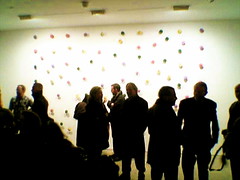What you might not have perceived right away is the pattern, or possible lack of the same, in the arrangement. Turns out that my friend's father is a frequent collaborator with Weinstein and wrote the code for a series of models to arrange the umbrellas according to a scheme oddly familiar to me (see below):
- Choose a random position in the box (and only in the box)
- If the umbrella is less than a minimum distance (d) from any other umbrella, try again.
This kind of model is all-too familiar for me in two scenarios:
- Particles emitted by nucleus-nucleus collisions always seemed to "clump" on our event displays. We argued for hours (turning into years) about the dynamical reasons for this kind of thing, but eventually realized the obvious: that Poisson statistics (which characterize truly random choices) always seem to show "clumpy" behavior!
- Nuclei are modelled by throwing nucleons into a roughly spherical distribution. Of course, experiments tell us that there is a "hard core" in the interaction between nucleons, making a minimum distance between them (at least in stable configurations) required for "physical" nuclei. My colleagues and I have been exploring the consequences of this "hard core" distance, and found that while some of our colleagues don't "like" the d=0 version (on the left: too many clumps!), you can only make it so big before it becomes unphysical again (on the right). In the latter case, it becomes larger than the known size (shown as a large sphere).


(These excellent images were made by Pete Walters, a PHOBOS colleague and one of Steve Manly's students at the University of Rochester -- I'll have a link when his full study for PHOBOS is made public!)
I'm still trying to figure out exactly why we think that "uniform" (i.e. unclumpy) distributions are more "random", or sometimes even more "physical", than truly random ones. My walk down 22nd street hasn't helped, but it's certainly got me thinking.



1 comment:
Hi Peter,interesting blog, and this post is really interesting!
Have you considered the particles having a condition related to the viscosity of pressure? If one drops a number of marbles into a container of oil, the "thickness" of the oil dictates the position of where the marbles end up?..now drop the same number of marbles into a similar volume of water..see what happens?
pv
Post a Comment